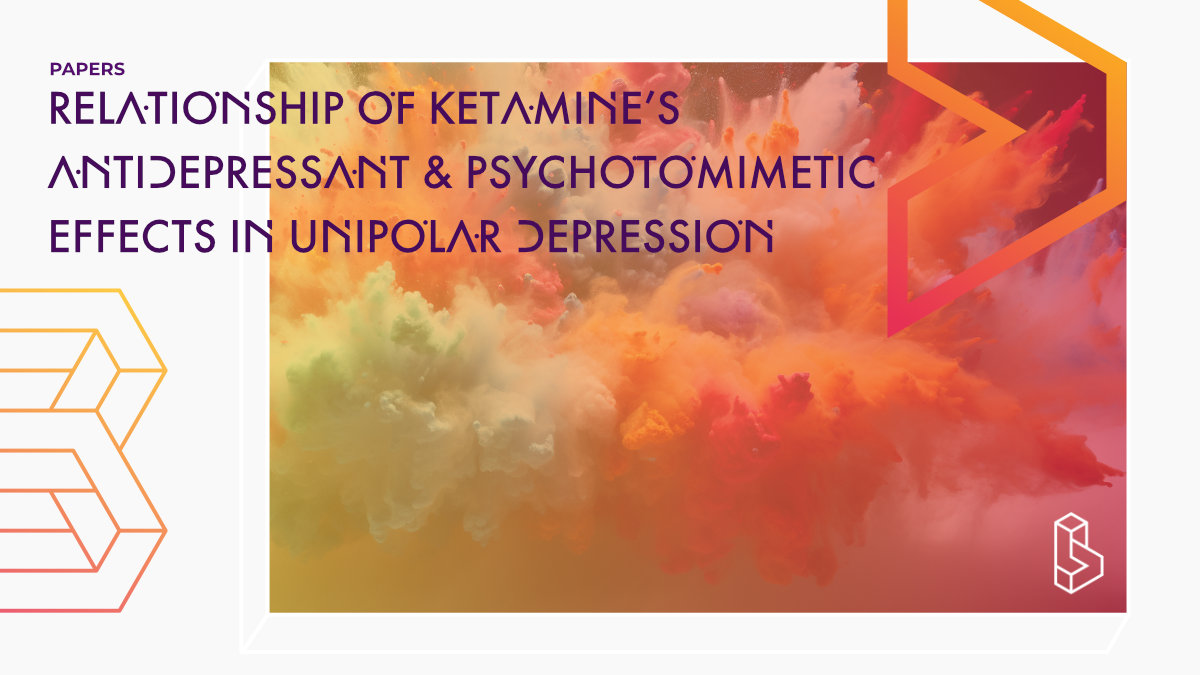This double-blind, cross-over, placebo-controlled study (n=27) investigated the antidepressant and psychotomimetic effects of a single ketamine infusion (38mg/70kg) in patients diagnosed with major depressive disorder (MDD). Ketamine infusion induced acute psychotomimetic symptoms, which correlated with alleviating negative mood ratings and improving depression symptoms in the days after.
Abstract of Relationship of ketamine’s antidepressant and psychotomimetic effects in unipolar depression
“Objectives: Ketamine and other NMDA (N-methyl-D-aspartate) antagonists produce fast-acting antidepressant-like effects, although the underlying mechanism is unclear. Furthermore, high affinity NMDA antagonists such as ketamine are associated with psychotomimetic effects. To date the link between the antidepressant and psychotomimetic effects of ketamine has not been explored. We examined the relationship between the antidepressant and psychotomimetic effects of a single ketamine infusion in subjects diagnosed with major depressive disorder.
Methods: In a double-blind, cross-over, placebo-controlled, two weeks clinical trial we studied the effects of ketamine (0.54 mg/kg within 30 min) in a group of 27 hospitalized depressive patients.
Results: Higher intensity of psychotomimetic symptoms, measured using BPRS, during ketamine administration correlated with alleviation in mood ratings during the following week with maximum on day seven. Ketamine was superior to placebo in all visits (day 1, 4, and 7) assessed by MADRS with effect size (Cohen´s d) of 0.62, 0.57, and 0.44 respectively. There was no significant correlation between ketamine and nor-ketamine plasma levels and MADRS score change at any study time point.
Conclusion: The substantial relationship between ketamine’s antidepressant and psychotomimetic effects was found. This relationship could be mediated by the initial steps of ketamine’s action, trough NMDA receptors, shared by both ketamine’s clinical effects.”
Authors: Peter Sos, Monika Klirova, Tomas Novak, Barbora Kohutova, Jiri Horacek, Tomas Palenicek
Summary of Relationship of ketamine’s antidepressant and psychotomimetic effects in unipolar depression
The dissociative anaesthetic ketamine has been shown to have fast-acting antidepressant-like effects, although the underlying mechanism is unclear. Ketamine is also associated with psychotomimetic effects.
Ketamine produces a wide range of psychotomimetic states depending on the individual, their expectations, the setting and the dose. The intensity of these alterations of consciousness and perception is dose-dependent.
Find this paper
Relationship of ketamine’s antidepressant and psychotomimetic effects in unipolar depression
Open Access | Google Scholar | Backup | 🕊
Cite this paper (APA)
Sos, P., Klirova, M., Novak, T., Kohutova, B., Horacek, J., & Palenicek, T. (2013). Relationship of ketamine’s antidepressant and psychotomimetic effects in unipolar depression. Neuroendocrinol Lett, 34(4), 101-107.
Study details
Compounds studied
Ketamine
Topics studied
Depression
Study characteristics
Placebo-Controlled
Double-Blind
Within-Subject
Randomized
Participants
27
Humans

